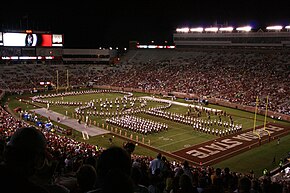Marching Chiefs
| The Florida State University Marching Chiefs | |
|---|---|
 |
|
| School | Florida State University |
| Location | Tallahassee, FL |
| Conference | ACC |
| Founded | 1939 |
| Director | Dr. Patrick Dunnigan (wind) Dr. David Plack (athletic) |
| Members | 470+ |
| Website | fsuchiefs |
The "World-Renowned" Florida State University Marching Chiefs is the official marching band of the Florida State University. The band has served in this capacity since the 1940s and continues to perform at all home football games as well as several away games each year. There are 420+ members, or Chiefs, as members are sometimes known, in the band who hail from almost every academic department within the university.
The first appearance of a formal band was organized in the late 1930s by Charlotte Cooper, Jean Hitchcolk, Allice Ludlaw, and director Owen F. Sellars. The band, which consisted of less than twenty students, performed at the Odds and Evens intramural football game on Thanksgiving Day 1939. The following year the Florida Flambeau ran an announcement of try-outs for the now established band. In 1942 Sellars took military leave for World War II and Frank Sykora became the interim director. The same year uniforms were purchased and worn for the first time at the inauguration of Doak S. Campbell as the new college president. 1946 saw the first option for students to take marching band for credit.
In 1947 the Florida State College for Women officially became Florida State University and the university was changed to coeducational by an act of the Florida Legislature. With the change to a coed school came the introduction of a male football team which competed in a five-game season. The marching band performed at the games and practiced on Landis Green under Robert Smith. 1949 saw a new director for the band, Robert T. Braungel, and the new, official name of "Marching Chiefs. The name was chosen by a newspaper survey sponsored by the Student Government Association. The first appearance of the newly christened Marching Chiefs was at Stetson University. Dr. Manley R Whitcomb became the new director of the Marching Chiefs in 1953 after transferring from Ohio State University and joining the FSU faculty. Dr. Whitcomb brought with him a talented young arranger by the name of Charles Carter who became the official arranger of the Marching Chiefs. Carter's arrangements gave the Marching Chiefs a distinctive style that survives to this day. Whitcomb also brought with him the traditional eight-to-five step, fast marching tempos, and the high step with arm swing now known as "Chief Step."
The 1949-50 football season saw the Seminoles' and the Marching Chief's first appearances in a postseason bowl game at the Cigar Bowl in Tampa, FL. 1954 marked the Seminoles next appearance in a bowl at the Sun Bowl in El Paso, Texas. The Miami Daily News proclaimed, "FSU's bid to Sun Bowl clinched by Marching Chiefs." In the spring of 1955 FSU received a charter of Kappa Kappa Psi honorary band fraternity. The brothers of KKPsi, as the organization is commonly known, produced a newsletter named The Chieftain which aimed to keep band members informed of upcoming events and activities. In 1956 Charlie Carter arranged J. Dayton Smith's The Hymn to the Garnet and the Gold for band. The Charlie Carter arrangement had its premier performance at the 1958 homecoming game.
...
Wikipedia
